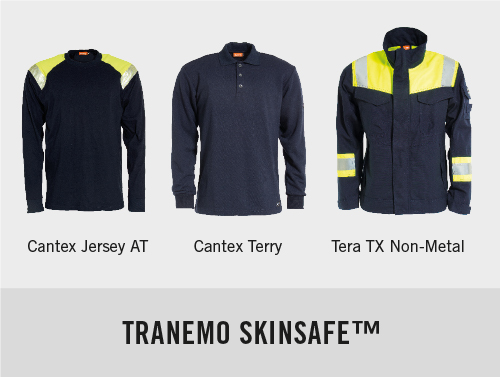
ATEX - EXPLOSIVE INDUSTRY
In situations where there is a risk that protective garments could generate sparks (an ignition source) that could ignite explosive material, flame retardant workwear that has anti-static properties is required. A combination of anti-static materials and correct garment design can eliminate the risk of sparks. Protective clothing with anti-static properties is extremely important when working with petrochemicals, gas and in other areas where there is a high risk of explosion.
RISK ASSESSMENT
- Risk of explosion / ATEX-environment
- Flame & Heat
RISK EVALUATION
When working in an ATEX-environments, Tranemo recommends garments certified according to standard EN 1149-5 in combination with EN ISO 11612. The Anti-Static properties of a garment minimise the risk of creating sparks (a source of ignition) which could cause an explosion. This is of significant importance when working in explosive areas e.g. petrochemicals, gas and other explosive industries.
The majority of our FR garments are EN 1149-5 certified. Anti-Static garments marked EN 1149-5 are intended to be worn with ATEX zones 1, 2, 20, 21 and 22. In oxygen enriched atmospheres or in zone 0, the Anti-Static garments should not be used without first being approved by a qualified Safety Engineer, as wear and tear can affect the protection of the garment and it is crucial that they are worn the correct way within these environments. Anti-Static garments have Anti-Static fibres woven into the fabric and the metal parts are covered according to the EN design requirements. The range Tera TX Non-Metal with visible details is especially suited for ATEX environments.
| Atex zone classifications for gas, mist and vapours | |
| Zone 0 | Environment where a mixture of air and flammable gas, mist or vapour occurs often and persists for long periods of time. |
| Zone 1 | Environment where a mixture of air and flammable gas, mist or vapour is likely to occur under normal conditions. |
| Zone 2 | Environment where a mixture of air and flammable gas, mist or vapour can occur under normal conditions but dilutes quickly. |
| Atex zone classifications for dust | |
| Zone 20 | Environment where explosive clouds of dust appear often and for extended periods. |
| Zone 21 | Environment where explosive clouds of dust can appear under normal conditions. |
| Zone 22 | Environment where explosive clouds of dust is not likely to appear and if they do, dissapears quickly. |

